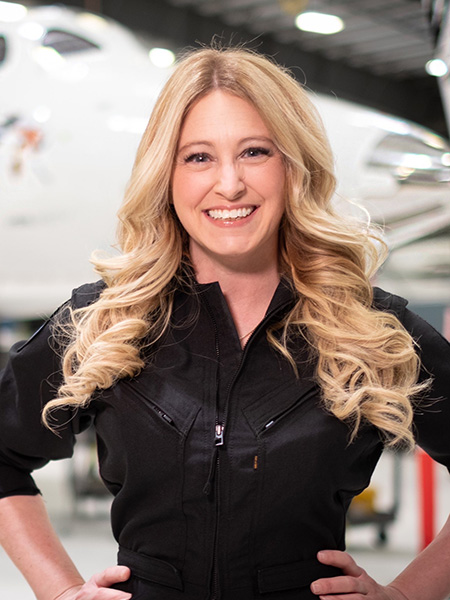Beth Moses
Astronaut and Chief Astronaut Instructor, Virgin Galactic
BSAAE 1992, MSAAE 1994
“The moment when I was most proud of becoming a professional astronaut was not the day it happened, not the day I was selected, not the day I first flew, but the day I was informed that this university was going to include me in the Cradle of Astronauts.”
Those were Beth Moses’ words when she visited Purdue in November 2023 as Mung Chiang’s guest during the Presidential Lecture Series.
She made history in 2019 when she flew to space in Virgin Galactic’s VSS Unity, becoming the first female commercial astronaut and securing her spot as the 25th member of the elite group. In conducting research on how future fliers would experience free-floating in the cabin, she became the first human ever to unbuckle and float around during a suborbital space flight.
Since joining Virgin Galactic in 2013, she has completed six of the company’s nine space flights. She pioneered the astronaut training program, shaping groundbreaking suborbital spaceflight experiences for private astronauts and researchers. And, she set a new standard for commercial space travel readiness after developing the inaugural cabin test program, introducing test protocols that exceeded safety and user experience benchmarks.
As a Purdue co-op student, she worked at NASA’s Johnson Space Center (JSC) and found out quickly that Purdue’s Aeronautics and Astronautics (AAE) curriculum was preparing her well.
“One day during the design of the space station, my NASA colleagues expressed concern that the truss might be too flimsy. They wanted shear and bending moment diagrams — a perfect student task! I cranked out a few diagrams, a colleague checked my math, and the work proved that docking plume loads could indeed break the station’s truss at the solar panel juncture.”
Directly after graduating from Purdue, she was hired at JSC. Within a decade, she rose to be the manager in charge of the extravehicular activity assembly of the International Space Station (ISS). Under her guidance, Moses’ team created and executed underwater worksite evaluations, suited human thermal vacuum testing, glove box testing, fluid line handling evaluations, and tool and connector fit checks.
Topping off her more than 20 years at NASA, she was the ISS commercial crew integration manager. She developed the first-ever technical requirements and processes for commercial crew vehicles, paving the way for private companies to achieve NASA certification.
“The thing I am most proud of is that no human was ever hurt on my watch, whether they were in a frozen vacuum chamber wrestling with giant ammonia hoses, underwater tussling with their space suit or finessing their seat belts in space while plummeting back toward the atmosphere,” Moses said.
Since 2016, Moses has been a member of AAE’s Industrial Advisory Council. In 2018, she was named an Outstanding Aeronautical Engineer, and in 2019, she was the keynote speaker at the Amelia Earhart Summit and participated in Purdue’s astronaut reunion.
“The AAE program demanded an almost-shocking work ethic while cultivating a sense of humility, camaraderie and teamwork,” she said.
If she had college to do all over again, what would she do differently?
“Nothing,” Moses said. “Purdue fully prepared me to succeed as both an engineer and a career astronaut, which I’ll never take for granted.”
Career Highlights
| 2013–present | Astronaut and Chief Astronaut Instructor, Virgin Galactic |
|---|---|
| 2011–2013 | International Space Station Commercial Crew Integration Manager, NASA Johnson Space Center |
| 2009–2011 | Lead, Constellation Program Extravehicular Activity Systems Vehicle Interface Team, NASA Johnson Space Center |
| 1995–2009 | Manager, International Space Station Extravehicular Activity System, NASA Johnson Space Center |
Education
| 1992 | BS Aeronautics and Astronautics, Purdue University |
|---|---|
| 1994 | MS Aeronautics and Astronautics, Purdue University |

